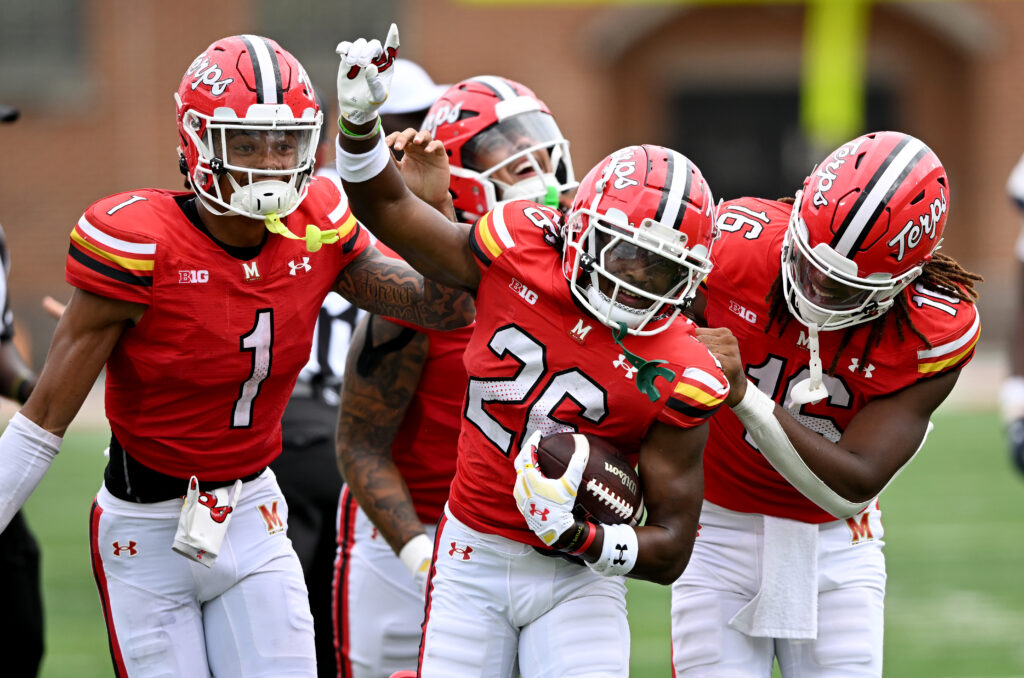University of Maryland players celebrate a fumble recovery during their Aug. 31 home game against the University of Connecticut. Kalman Hettleman asks if big-time sports are good for colleges and universities. Photo by Greg Fiume/Getty Images
It’s good news that in May, the National College Athletic Association and its power conferences agreed to pay college athletes over the next decade an estimated $2.8 billion from the megabucks that football and basketball teams generate. Athletes can give it the old college try while making a helluva lot of money.
But here’s a much better idea: Abolish big-time college football and basketball altogether.
Am I delusional? College football and basketball account for well over $1 billion in annual revenue. In data from 2020-2021, the University of Maryland took in $107.5 million in sports revenue, yet ranked only 43rd among all universities.
On top of that, between 2005 and 2022, gung-ho alumni booster groups raised a staggering $2 billion. The Terrapin Club group hauled in $194 million, yet ranked only 49th among the high-rollers.
A business finance expert estimated that, based on its revenues, the University of Michigan football team would be valued as a private business at between $1 and 1.5 billion. A recent article detailed how private equity firms “are maneuvering to invest in college athletes, their schools, and the conferences they play in.” The Big Ten, which includes the University of Maryland, just entered into a $7 billion TV contract.
Unfortunately, the players’ $2.8 billion settlement didn’t come about because of public pressure for colleges to end the sham of amateurism in big-time sports. Instead, it resulted from players scoring big in lawsuits.
Litigation is still pending, and many details remain to be worked out. But a historic revolution in college sports has happened.
Still, even if players are paid well, big-time athletics will continue to make a mockery of the purpose and integrity of higher education. Sure, students, alumni and other sports fans have a lot of fun. As one writer put it, “most administrators of higher education won’t argue with the fact that their athletic programs are the center of educational community.”
But universities are supposed to educate not entertain, much less be money-making machines.
Professors shouldn’t be second-class citizens. In 2022, the base salary of the president of the University of Maryland was $840,000 while the basketball coach’s base salary was $1.5 million (no doubt augmented by lucrative outside deals). In 2023, the football coach earned $5.68 million. Half of the 110 highest-paid people at the university worked in athletics.
At my alma mater, Duke University (where I played for two sports teams but wasn’t worth a cent), in 2022, the president’s salary was over $2 million. But famed basketball coach Mike Krzyzewski, after he retired, was paid nearly $9 million as a goodwill ambassador. (That’s year-round, not just March, Madness.)
This rampant commercialism in sports is fundamentally unknown in other countries. It’s been noted, “In Europe, Canada, and Central and South America, the notion of playing athletics “for your local high school or even a university is, well, foreign,” The norm elsewhere is private clubs or intramural competition.
And many U.S. universities, from small to Ivies, don’t offer athletic scholarships, while others renounce all major sports. These outlier schools hardly suffer in popularity and applications. The University of Chicago is an exemplar. The all-star political writer Robert Kuttner cites the example of Northeastern University in Boston: After dropping its 74-year-old football program in 2009, it has risen from 96th to 40th among the most popular U.S. colleges.
Two frequent justifications are advanced by defenders of the commercial status quo. One, that big-time sports pay for other athletic programs. However, intramural competition and private clubs wouldn’t need significant subsidies.
The other is that big-time sports provide opportunities for some low-income students, predominantly Blacks, who wouldn’t otherwise be able to afford college. But, even putting aside the availability of nonathletic scholarships and financial aid, how is it equitable for students who can score touchdowns or slam-dunk to gain preference over those who have equal or better grades and, say, play the violin or write poetry?
There’s also another big reason for big-time sports to be abolished. American universities have many more weighty problems than sports to contend with. No one can doubt the crisis in higher education, including declining enrollments and fiscal shortfalls, not to mention escalating controversies over free speech and demonstrations on campuses.
No wonder “Large numbers of Americans appear to have soured on the idea that a college degree is worth the trouble, especially if it comes with a staggering debt load.” And the U.S.’s longstanding supremacy over universities in other countries seems to be slipping.
The game clock is running out. And U.S. higher education needs a comeback to win back its integrity and purpose. Let’s cheer for that to happen.

